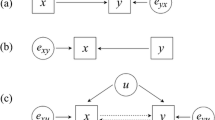Abstract
Researchers often hypothesize moderated effects, in which the effect of an independent variable on an outcome variable depends on the value of a moderator variable. Such an effect reveals itself statistically as an interaction between the independent and moderator variables in a model of the outcome variable. When an interaction is found, it is important to probe the interaction, for theories and hypotheses often predict not just interaction but a specific pattern of effects of the focal independent variable as a function of the moderator. This article describes the familiar pick-a-point approach and the much less familiar Johnson-Neyman technique for probing interactions in linear models and introduces macros for SPSS and SAS to simplify the computations and facilitate the probing of interactions in ordinary least squares and logistic regression. A script version of the SPSS macro is also available for users who prefer a point-and-click user interface rather than command syntax.
Similar content being viewed by others
References
Aiken, L. S., & West, S. G. (1991). Multiple regression: Testing and interpreting interactions. Thousand Oaks, CA: Sage.
Bauer, D. J., & Curran, P. J. (2005). Probing interactions in fixed and multilevel regression: Inferential and graphical techniques. Multivariate Behavioral Research, 40, 373–400.
Bissonnette, V., Ickes, W., Bernstein, I., & Knowles, E. (1990). Personality moderating variables: A warning about statistical artifact and a comparison of analytic techniques. Journal of Personality, 58, 567–587.
Cohen, J., Cohen, P., West, S. G., & Aiken, L. S. (2003). Applied multiple regression/correlation analysis for the behavioral sciences (3rd ed.). Mahwah, NJ: Erlbaum.
Cronbach, L. J. (1987). Statistical tests for moderator variables: Flaws in analyses recently proposed. Psychological Bulletin, 102, 414–417.
Darlington, R. B. (1990). Regression and linear models. New York: McGraw-Hill.
Hayes, A. F. (2005). Statistical methods for communication science. Mahwah, NJ: Erlbaum.
Irwin, J. R., & McClelland, G. H. (2001). Misleading heuristics and moderated multiple regression models. Journal of Marketing Research, 38, 100–109.
Jaccard, J., & Turrisi, R. (2003). Interaction effects in multiple regression (2nd ed.). Thousand Oaks, CA: Sage.
Johnson, P. O., & Fay, L. C. (1950). The Johnson-Neyman technique, its theory and application. Psychometrika, 15, 349–367.
Johnson, P. O., & Neyman, J. (1936). Tests of certain linear hypotheses and their application to some educational problems. Statistical Research Memoirs, 1, 57–93.
Karpman, M. B. (1983). The Johnson-Neyman technique using SPSS or BMDP. Educational & Psychological Measurement, 43, 137–147.
Karpman, M. B. (1986). Comparing two non-parallel regression lines with the parametric alternative to analysis of covariance using SPSS-X or SAS—the Johnson-Neyman technique. Educational & Psychologicals Measurement, 46, 639–644.
Kromrey, J. D., & Foster-Johnson, L. (1998). Mean centering in moderated multiple regression: Much ado about nothing. Educational & Psychological Measurement, 58, 42–67.
MacCallum, R. C., Zhang, S., Preacher, K. J., & Rucker, D. D. (2002). On the practice of dichotomization of quantitative variables. Psychological Methods, 7, 19–40.
Newsom, J. T., Prigerson, H. G., Schulz, R., & Reynolds, C. F., III (2003). Investigating moderator hypotheses in aging research: Statistical, methodological, and conceptual difficulties with comparing separate regressions. International Journal of Aging & Human Development, 57, 119–150.
O’Connor, B. P. (1998). SIMPLE: All-in-one programs for exploring interactions in moderated multiple regression. Educational & Psychological Measurement, 58, 836–840.
Potthoff, R. F. (1964). On the Johnson-Neyman technique and some extensions thereof. Psychometrika, 29, 241–256.
Preacher, K. J., Curran, P. J., & Bauer, D. J. (2006). Computational tools for probing interactions in multiple linear regression, multilevel modeling, and latent curve analysis. Journal of Educational & Behavioral Statistics, 31, 437–448.
Reineke, J. B., & Hayes, A. F. (2007, November). Reporting on campaign finance success: Effects on perceptions of political candidates. Paper presented at the annual meeting of the National Communication Association, Chicago.
Rogosa, D. (1980). Comparing nonparallel regression lines. Psychological Bulletin, 88, 307–321.
Stone-Romero, E. F., & Anderson, L. E. (1994). Relative power of moderated multiple regression and the comparison of subgroup correlation coefficients for detecting moderator effects. Journal of Applied Psychology, 79, 354–359.
Author information
Authors and Affiliations
Corresponding author
Rights and permissions
About this article
Cite this article
Hayes, A.F., Matthes, J. Computational procedures for probing interactions in OLS and logistic regression: SPSS and SAS implementations. Behavior Research Methods 41, 924–936 (2009). https://doi.org/10.3758/BRM.41.3.924
Received:
Accepted:
Published:
Issue Date:
DOI: https://doi.org/10.3758/BRM.41.3.924




